5. Area health services
NSW Public Health Bulletin 21(1) 26-34 https://doi.org/10.1071/NB10S05
Published: 24 June 2010
Information on the health of Aboriginal and Torres Strait Islander mothers and mothers born in non-English speaking countries is shown in Chapters 7 and 8, respectively.
Confinements
The largest numbers of mothers who gave birth in 2007 were resident in the Sydney South West Area (n = 21 206, 22.4%), followed by the Sydney West Area (n = 18 068, 19.1%) and the South Eastern Sydney and Illawarra Area (n = 15 597, 16.5%) (Table 20).
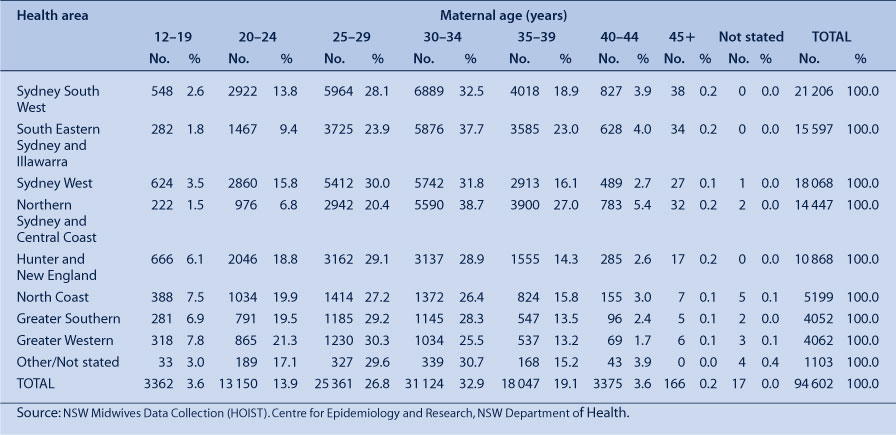
|
Maternal age
The proportion of women giving birth at less than 20 years of age varied from 1.5% in the Northern Sydney and Central Coast Area to 7.8% in the Greater Western Area, whereas the proportion of mothers giving birth at 35 years of age or more ranged from 15.1% in the Greater Western Area to 32.6% in the Northern Sydney and Central Coast Area (Table 20).
Maternal country of birth
Seventy-seven percent of women who gave birth in NSW in 2007 were born in English speaking countries, 13.0% were born in Asian countries, and 4.6% were born in the Middle East or Africa (Table 21).
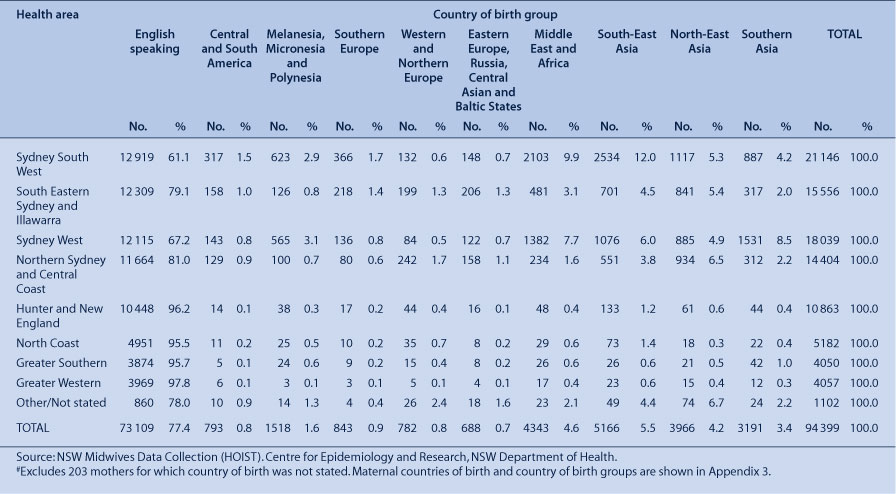
|
The highest proportions of mothers born in non-English speaking countries were in the Sydney South West and Sydney West Areas. In the Sydney South West Area, the majority of mothers born in non-English speaking countries were born in South-East Asia, the Middle East and Africa. In the Sydney West Area, the most common non-English speaking maternal countries of birth were in Southern Asia, the Middle East and Africa.
Maternal Aboriginality
In 2007, 3.1% of mothers were reported to be Aboriginal or Torres Strait Islander (Table 22). The proportion of Aboriginal or Torres Strait Islander mothers varied from 0.9% in the Northern Sydney and Central Coast Area to 13.5% in the Greater Western Area.
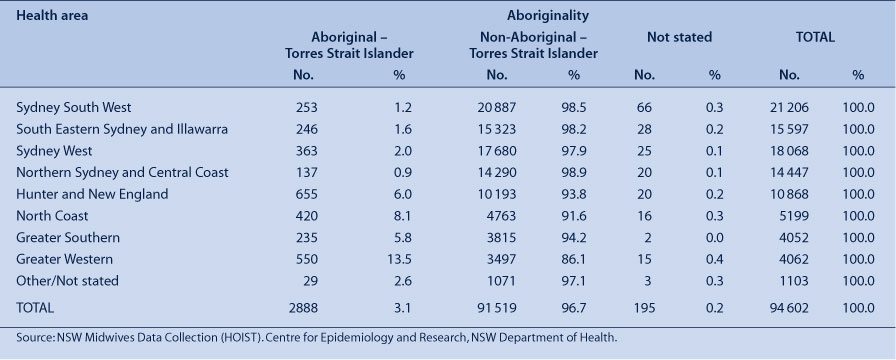
|
Duration of pregnancy at first antenatal visit
In 2007, 90.7% of mothers commenced antenatal care prior to 20 weeks gestation. This percentage varied from 83.7% in the Sydney South West Area to 95.9% in the Northern Sydney and Central Coast Area (Table 23).
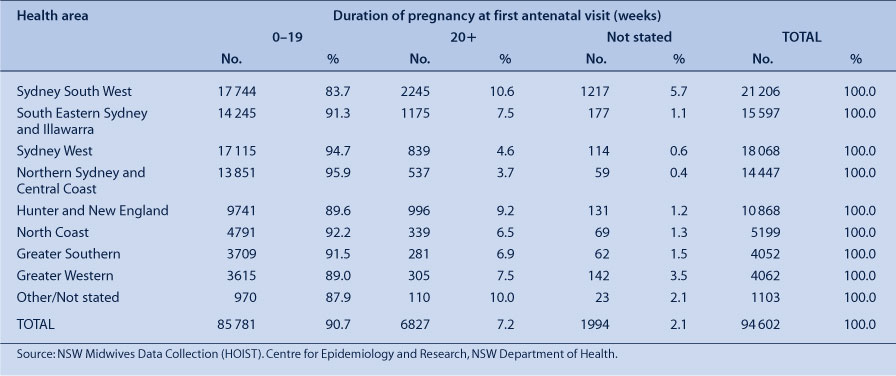
|
Smoking in pregnancy
In 2007, 12.0% of mothers reported smoking in the second half of pregnancy (Table 24). The lowest reported rate was among mothers resident in the Northern Sydney and Central Coast Area (5.8%) and the highest rate among residents of the Greater Western Area (25.8%).
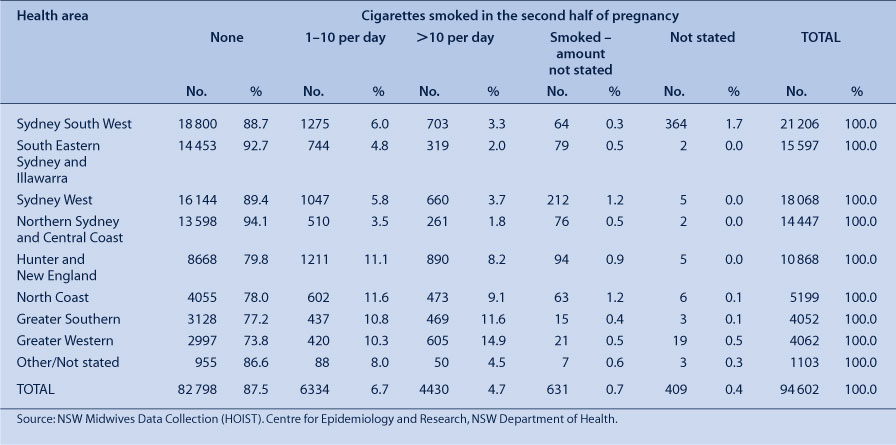
|
Place of birth
Ninety-five percent of mothers chose to deliver in a hospital birthing suite in 2007, compared with 4.1% who planned a birth-centre birth and 0.2% who planned a home birth (Table 25). Planned birth-centre births were most commonly reported in the Sydney West, Hunter and New England, and South Eastern Sydney and Illawarra Areas.
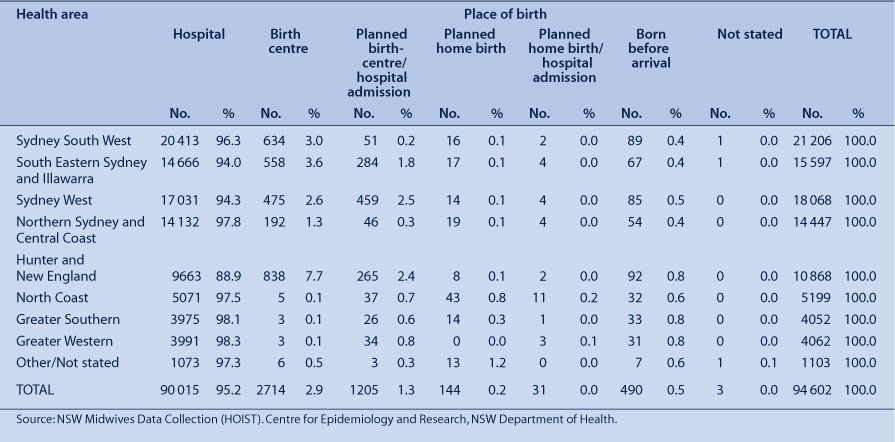
|
Labour
In 2007, the onset of labour was spontaneous in 57.3% of confinements (Table 26). Labour was induced in 25.9% of confinements and no labour (elective caesarean section) was reported in 16.8%. The rate of spontaneous onset of labour was highest among residents of the North Coast Area (64.4%). The highest rate of induction of labour was among residents of the Sydney West Area (29.2%).

|
Birth
Sixty percent of confinements were by normal vaginal birth, 10.6% were instrumental and 29.0% were by caesarean section (Table 27). The highest rate of normal vaginal birth was among residents of the North Coast Area (67.7%), whereas the highest rates of instrumental birth were among residents of the South Eastern Sydney and Illawarra Area (13.1%). The caesarean section rate varied from 25.4% among mothers resident in the Hunter and New England Area to 35.7% in the Northern Sydney and Central Coast Area.
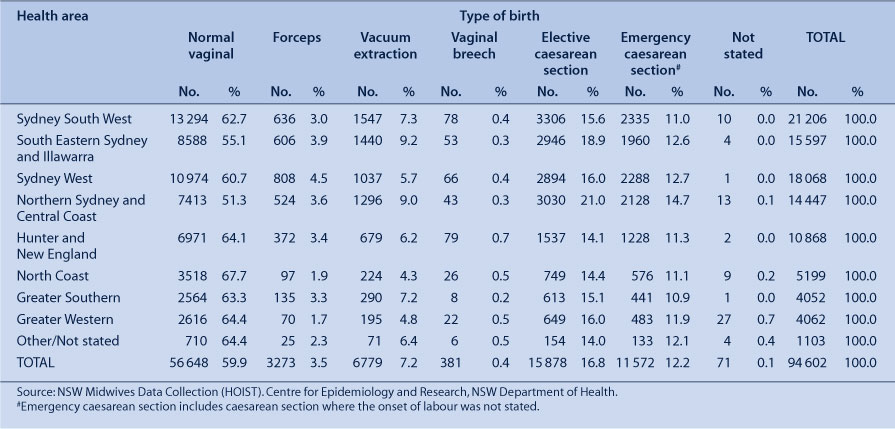
|
Birth weight
In 2007, 6.1% of births were low birth weight (less than 2500 g). These comprised 0.7% of birth weight less than 1000 g, 0.5% in the 1000–1499-gram range and 4.9% in the 1500–2499-gram range (Table 28). Rates of low birth weight ranged from 4.6% in Greater Southern Area to 7.3% in the Hunter and New England Area.
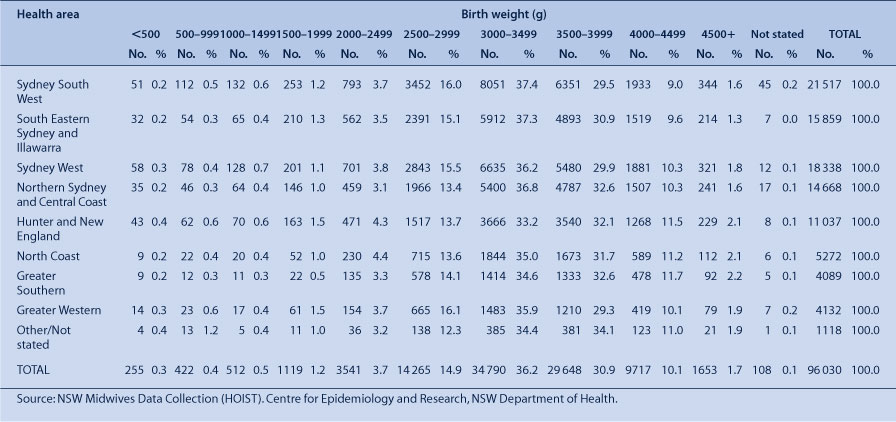
|
Gestational age
The majority of births (91.6%) were at term, and 0.9% were post-term (42+ weeks). The 7.4% of preterm births comprised 0.7% born at less than 28 weeks, 0.7% at 28–31 weeks, and 5.9% at 32–36 weeks. The highest rate of preterm birth was in the Hunter and New England Area (8.8%), whereas the lowest was 5.1% in the Greater Southern Area (Table 29).
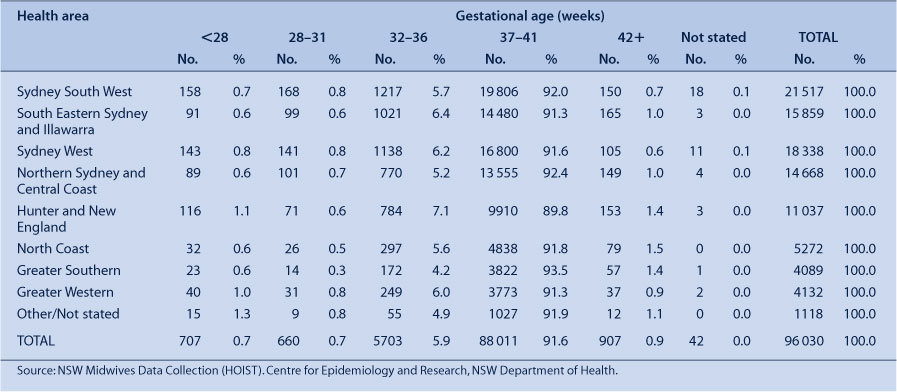
|
Infant feeding
In 2007, infant feeding on discharge from hospital was reported for 95 212 live births (Table 30). The majority of babies (78.9%) were reported to be fully breastfed, 12.9% were receiving infant formula only, and a further 6.4% were being partially breastfed. Rates of full breastfeeding varied from 72.2% in the Sydney South West Area to 85.8% in the Northern Sydney and Central Coast Area.
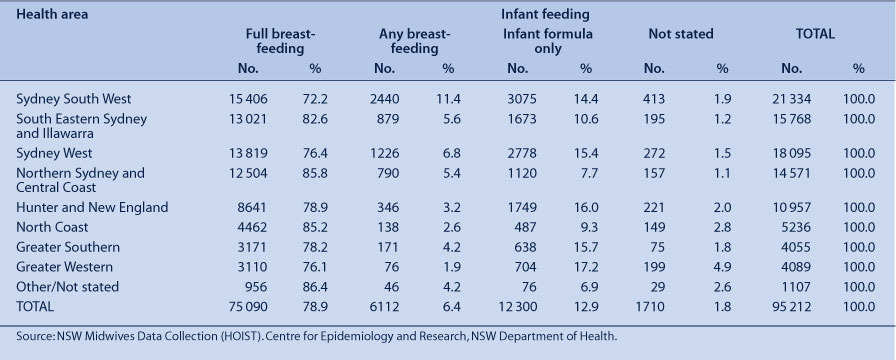
|
Perinatal outcomes
The perinatal mortality rate in 2007 was 9.0 per 1000 births. This rate includes all live births, and stillbirths of at least 400 g birth weight or at least 20 weeks gestation (Table 31). The perinatal mortality rate varied from 7.4 per 1000 in the Northern Sydney and Central Coast Area to 12.1 per 1000 in the Greater Western Area.
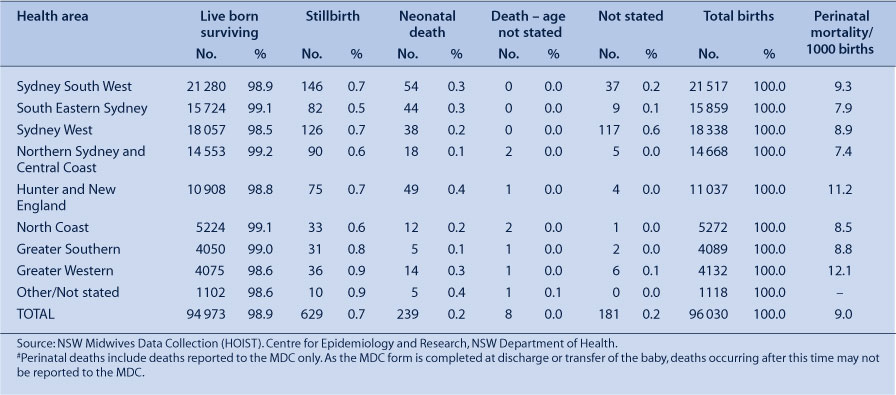
|
Live births by statistical local areas (Table 32)
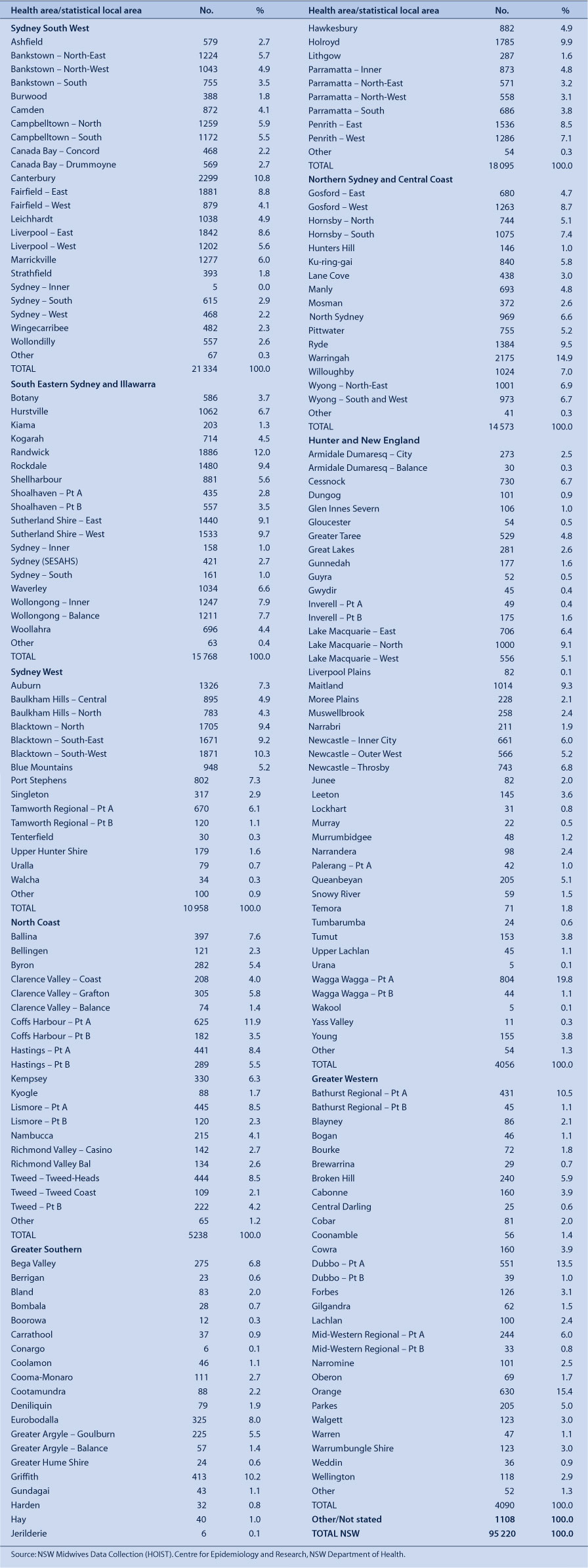
|


